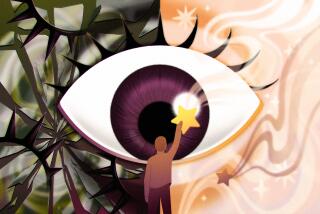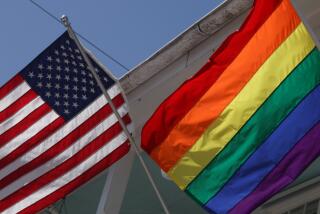No, We’re Not Taught to Hate : But We Can Overcome Instinct to Fear ‘the Other’
- Share via
A wide spectrum of group intolerance appears to be increasing on the nation’s college campuses, including harassment on the basis of racial, cultural, religious and even sexual differences.
What is it that this racism and sexism and homophobia and religious and cultural intolerance have in common? They are all ways of denying that other people are of the same kind as ourselves. This denial can be blatant, as in the hurling of ugly epithets or the physical harassment or coercion of another. Or it can be subtle and even unconscious, as when the contributions of some members of a group are consistently ignored or belittled. Sadly, this is one of the basic characteristics that all of us human beings have in common: our tendency to categorize and stereotype other groups of people as inferior to ourselves, and to use them as convenient objects of blame and animosity.
But whatever the manifestation and whoever the target, group hatred and suspicion arise from a primitive psychological mechanism that has nothing to do with the race, color, creed, gender or sexual orientation of the excluded others.
Briefly, in terms of developmental psychology, here is how this mechanism of hate arises: An infant’s first laboratory assignment in becoming a human being is to discover that it and its mother are two separate entities. Then comes the discovery of boundaries between self and others, along with the ability--for the sake of species survival--to form strong family ties.
Paradoxically, this process that creates our species’ ability to love also is the source of our ability to hate. The most commonly used example of this connection is the so-called recognition sequence observed in infants. Before an infant learns to distinguish its own mother from all others, it shows no fear of strangers. It is only when it recognizes the mother bond that fear and rejection of other people develop, and the infant embarrasses the family by screaming with terror at the approach of kind old Uncle Sigmund.
In the formation of groups, you and I--all human beings--duplicate the earliest conditions of our lives by this instinctual bonding mechanism. But then, having formed groups for necessary and benign reasons, all too often--and for the most part unconsciously--human beings take the next step that fears and rejects, that differentiates between the beloved familiar and the stranger, between the in-group and the out-group, between us and them. To strengthen the bonding, the in-group identifies itself as superior to the out-group, even where significant differences between the people involved are virtually nil. Then, the in-group proceeds to defend this difference as though it were a vital, objective reality, rather than an inner, psychological choice.
Consider in this light the irony of Hitler’s requirement that Jews wear the Star of David, without which these supposedly inferior others would have been indistinguishable from the rest of the German population.
Knowledge of the process of bonding and group formation allows us to see ourselves in the larger context of our history as a species. We psychiatrists depend on a very important axiom in our work: that what is unconscious is not within a person’s control, but what is made conscious is available for human beings to understand, to change or to reinforce.
We as a species can no longer afford not to recognize our own infantile behavior. The human race has the power to blow up the world, and yet we continue to allow our actions, both personally and as nations, to be controlled by a psychological hate mechanism on autopilot. And all the while, we vigorously maintain our own innocence of any wrongdoing. Like warring children we fiercely insist that it wasn’t our fault, that the envied or feared “other” stepped over the imaginary line, “got on my side,” and “made me do it.” We project onto others--of another color, of another creed, of another culture--our own fears, angers, imperfections; all the things about ourselves that we dislike, we attribute to someone else, to the members of the out-group--even, at times, to people who simply happen to be of the opposite sex.
The Swiss psychiatrist Carl Jung had a picturesque term for this psychological element commonly observed in human beings. He referred to it as the “shadow,” the projection of each individual’s darker side. Because it is so uncomfortable for us to acknowledge our own faults and recognize the possibilities for evil within our own natures, we repress the knowledge of our shadow, and with relief turn it outward. “You can then at least say, without hesitation, who the devil is,” Jung wrote; “you are quite certain that the cause of your misfortune is outside and not in your own attitude.”
It has been a troubling acknowledgment for universities and colleges to make, that in this privileged enclave where we talk about and think about and teach the lessons of humane learning, we have not necessarily been educating our community in attitudes of tolerance and humility. We have come to realize that we must be explicit, that the naturally broadening and civilizing process of a liberal arts education is not enough, by itself, to accomplish the goals of community we have set before us. We must engage intolerance and inhumanity openly and publicly, as a community, at every opportunity.






